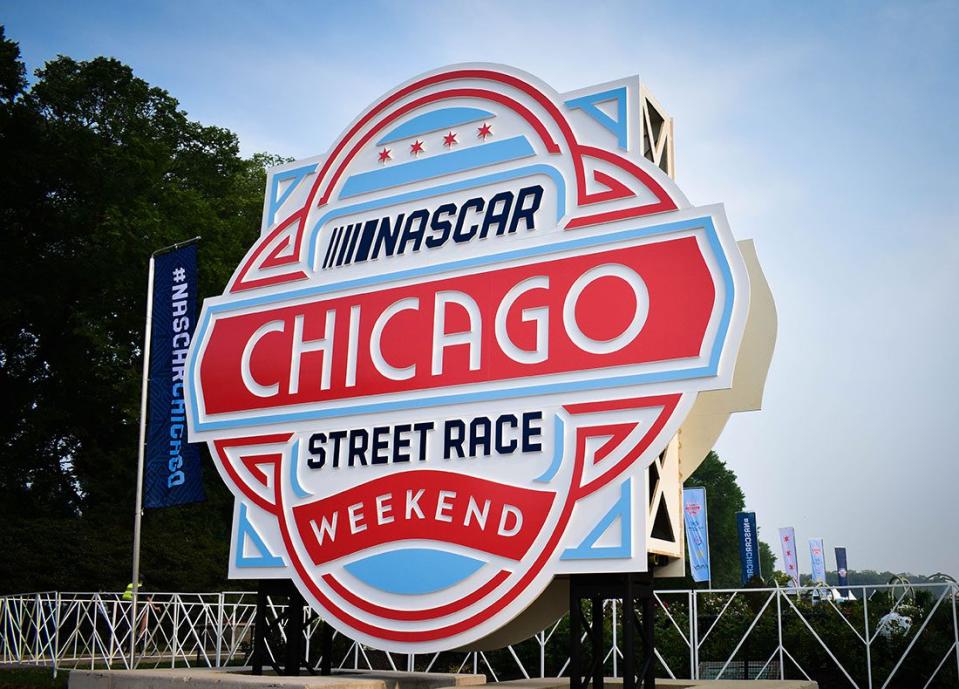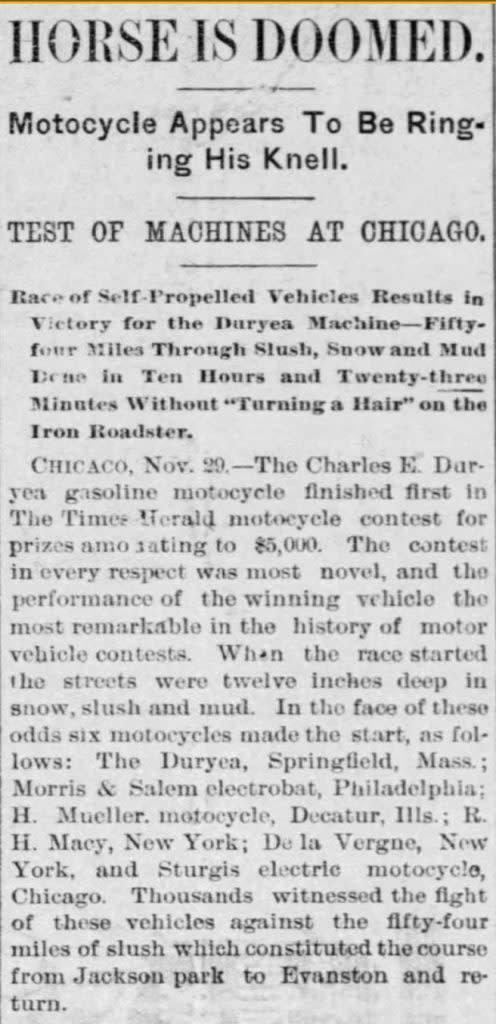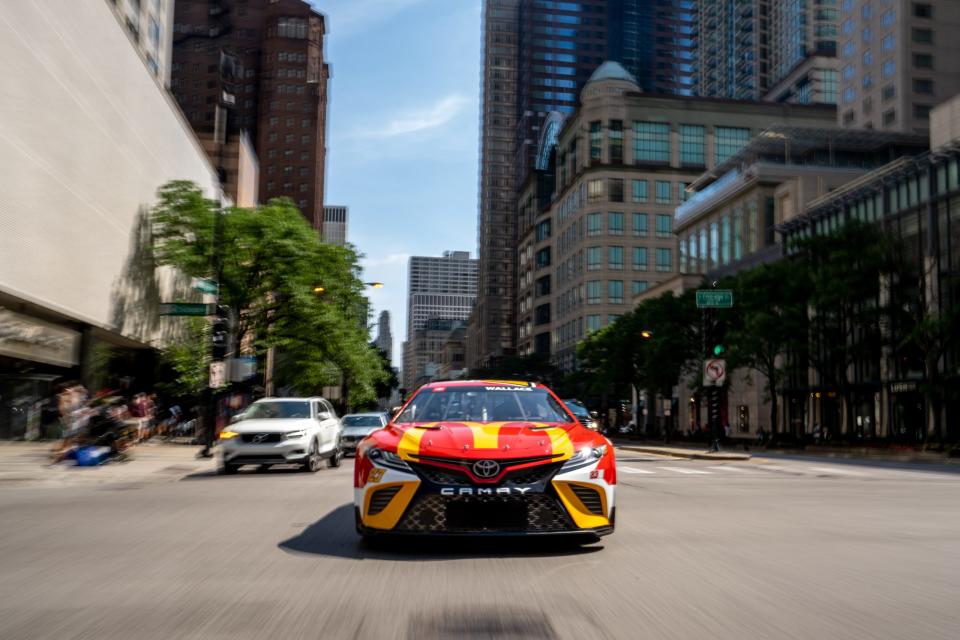Before the Chicago Street Race, there was the race that started it all
Only race-winning cars deserve nicknames, and its owners dubbed this one the “Chicago car.” Emblazoned with a “5” on its side, it featured a two-cylinder engine, a control arm instead of a steering wheel, rear tires considerably larger than the front and no roof, doors or safety features.
On Nov. 28, 1895 — Thanksgiving morning — an inventor named Frank Duryea sat in the Chicago car in Chicago‘s Jackson Park and hoped to drive his way into history. At 8:55 a.m., a man named Judge Kimball yelled “go,” and at that command, Duryea, sitting on the right side of the car, used a combination of governor and hand control to engage the 1.75 horsepower his engine generated. The Chicago car‘s tires found traction, the car inched across the starting line, and at that precise moment, automobile racing was born in the United States.
On a blustery, snowy and cold day in Chicago, the first automobile race in U.S. history played out like a slow-motion cross between Keystone Kops, Cannonball Run and Little Rascals. The race had weather problems, scheduling problems, route problems and inspection problems. It featured boys throwing snowballs at the cars, arcane rules and annoyed race officials. The result sparked a family feud that lasted decades.
Dozens of cars signed up, but only six showed up. Only two of those finished, and one of those drivers was so cold and tired he passed out before the race ended, which forced an umpire assigned to his car to coax it across the finish line. Despite all that, the importance of that first race reverberates today, 128 years later, as one of the most significant days in the history of transportation.
“We had opened a new era,” wrote Charles Duryea, Frank‘s brother, after the Chicago car won the race. “We had set forth a new type of vehicle.”
Lest you think that‘s Victory Lane bravado, this is how automotive historian Richard Scharchburg put it: “More than any other event in the world, (it) opened the door for the automobile age.”
New era!
New vehicle!
Opened the door for the automobile age!
And you thought NASCAR‘s first-ever street race in Chicago this weekend was mad-hyped.
• • •
One day in May, 1895, H.H. Kohlsaat, the owner of the Chicago Times-Herald, was lounging at the Chicago Club when he picked up a French magazine. It contained an account of an automobile race from Paris to Bordeaux. The story inspired Kohlsaat — why not hold a race in Chicago? His newspaper could publicize it, fund prize money and seize on interest in these newfangled horseless carriages.
However bold Kohlsaat‘s idea was in 1895, holding a NASCAR race in the streets of downtown Chicago in 2023 rivals it. Like Charles Duryea 128 years ago, NASCAR sees the Chicago Street Race as opening a new era. NASCAR has never tried anything like this and has cast this weekend‘s Grant Park 220 as an attempt to rethink, reimagine and reinvent the race-day experience from a driver, fan and broadcast perspective.
RELATED: Chicago Street Race schedule | Turn-by-turn tour of the course
The sport tabbed Julie Giese, who oversaw a massive renovation project at Phoenix, to run it. She moved to Chicago, hired a staff of more than a dozen and relishes the opportunity to make history with the races this year. “I enjoy building things from the ground up,” she says. “I like blank sheets of paper.”

This weekend‘s course covers a very small portion of the course run in 1895, a happy coincidence NASCAR found out about after plotting the track. The 1895 race was one lap, to Evanston and back. This race will be 100 laps on a 2.2-mile course on some of the most famous real estate in the country. “The footprint that we‘re racing on is so iconic,” Giese says.
The cars will scream across Michigan Avenue (just like in 1895 only 100-plus miles per hour faster) and barrel over Lake Shore Drive within shouting distance of Lake Michigan. The views — from the cockpit, grandstand, pit road, concourse and everywhere else — will be unlike anything in the history of the sport.
“It‘s our 75th year. I think it‘s hard to find things where you‘re able to say you‘re doing it for the first time,” Giese says. “And so I think unprecedented is a good word for what we‘re doing.”
That was a good word for what happened in Chicago in 1895, too.
That race was postponed repeatedly because there weren‘t enough cars available, perhaps giving rise to the old joke that the first car race was held five minutes after the second car was built. Finally, Kohlsaat confirmed Thanksgiving as race day. Plenty of cars were ready by then, which, as it turns out, was not necessarily good news. As Cord Scott, writing in Journal of the Illinois State Historical Society, put it: “The twenty-eighth of November was the worst possible day for an automobile race.”

Heavy snow blanketed the streets. Snow tires had not been invented yet, nor had radar, over-caffeinated meteorologists, red flags or weather delays. There was also this: The streets were open just like any other day, and “it was not uncommon for overworked horses to drop dead in the streets,” Scott wrote. “The carcasses then had to be hauled off by other horses before they caused hygiene and odor problems.”
If the race cars avoided dead horses, they had to contend with live people. Chicagoans who braved the cold to go outside in the snow saw no need to yield to the competitors, if they even knew they were competitors, which they probably didn‘t because there had never been a race in America so how would anyone know what a race car driver looked like?
Most of the cars had little to no brakes. So these men who had zero experience racing were driving cars with primitive steering … and little to no brakes … while boys threw snowballs at them … on snow-covered and deeply rutted roads … that might have had dead horses on them and definitely had live people on them.
And you thought the way the surface at Darlington eats tires made races interesting.
• • •
As Charles and Frank Duryea traveled to the starting line, they passed a competitor who had been stuck in the snow for 20 minutes. They wondered if their own vehicle would make it there. It‘s hard enough to drive in snow and slush now. In 1895, it was almost impossible. Making matters worse, the Duryeas realized their steering wasn‘t working properly. “So we simply trusted to luck and tried to forget that our steering was not all right,” Charles wrote.
Along with no steering, they had no clue what would happen in the race. There‘s more than a little uncertainty going into this weekend‘s race, too. This is as unpredictable of an event as NASCAR has ever had, and that‘s saying something, because NASCAR has made a habit lately of creating tracks where there didn‘t use to be one (the Los Angeles Memorial Coliseum), cobbling one track out of two (Charlotte‘s Roval, the Daytona Road Course) and racing on a new surface at an old track (Bristol dirt).
“In the last few years, NASCAR really has been pushing their boundaries,” says Ken Martin, the director of historical content for NASCAR. “What we see with the development of Chicago can have a big impact on some of the directions we may go in the future.”
It‘s anybody‘s guess what we‘ll see. As Eric Warren, GM‘s executive director of global motorsports competition, put it, nobody will have even driven the course in a rental car before it opens Saturday morning. If NASCAR‘s scheduling operating principle lately has been, “what the hell, let‘s try it,” the race in Chicago takes that to a whole new level.
“The venue is going to be pretty unique,” Warren says with more than a little understatement. “We kind of know the layout, there‘s some simulation kind of getting made up. But it‘s public streets. People are going to make some choices, let‘s say, as far as how you run the suspension, how you deal the aerodynamics, not really, truly knowing how rough the track is going to be.”
At least there won‘t be any people on the track.
Or snow.
Or boys throwing snowballs.
“I think it‘s going to be a little bit of a mystery who‘s going to be successful there,” Warren said.
RELATED: NBC crew on courage of NASCAR running a street race
At least it‘s clear how they‘ll be successful: By careening into corners, waiting until the last possible second to brake and executing breathtaking side-by-side passes.
None of that happened in 1895.
Side-by-side racing had not been invented and was not invented on that day. Apparently organizers deemed it a terrible idea. A staggered start kept the cars separate and the rules called for a slower car to yield when a faster car approached. “In no case may two vehicles move along abreast of each other,” the rules said.
Even with those rules, wrecks marred the day. Driver Jerry O‘Connor withdrew after three of them, all of which involved (live) horses, and none of which included fellow competitors, unless you include Frederick Haas, who had already withdrawn from the race and happened to be in a horse-drawn sleigh O‘Connor bashed into. O‘Connor probably would have hit the pace car, too, only it hadn‘t been invented yet.
An umpire rode shotgun in every car, proof that fear of cheating in racing is even older than actual cheating in racing. As one writer put it, team owners feared “invention pirates” would steal their designs before they could perfect and patent them.
Decades later, Frank Duryea described the race in a short book called America‘s First Automobile. He wrote that he made two unscheduled pit stops, not that anybody knew to call them that yet. In the first, he stopped at a blacksmith‘s shop to fix the steering arm, which had broken off when the left front wheel hit a rut, a problem foreshadowed on their way to the starting line.
In the second, one of the engine‘s two cylinders stopped firing. “I put the machine in low gear and with one cylinder operating, drove on until a tinsmith‘s shop was sighted. It being a holiday, the shop was closed and the smith asleep at home,” he wrote. “Mr. White (his umpire) and I got him up and induced him to open the shop.”
Frank Duryea spent 55 minutes fixing the problem. From there, he motored on to the finish line … except for the four minutes he spent waiting for a passing train. (Giese on the possibility of a train delay this weekend: “Nope,” she said with a laugh. “Not here.”)
He returned to Jackson Park at 7:18 p.m. He had covered the 53.5 mile-route in 10 hours and 23 minutes, for an average speed of slightly more than 5 miles per hour. But if you take out the three hours he spent making repairs, getting lost (!), etc., the average speed topped 7 miles per hour.
Oscar Mueller entered the only other vehicle to finish. When it pulled into Jackson Park, Mueller was no longer driving. His umpire, Charles King, was. King steered with one hand and used the other to prop up Miller, who had passed out due to cold and exhaustion.
King crossed the line 95 minutes after Frank Duryea.
And you thought Kyle Larson dominated the All-Star Race.
• • •

When whoever wins this weekend‘s race crosses the start/finish line, his victorious moment will be viewed live by millions of people around the world. He will do an epic burnout (hopefully). NBC will beam his post-race interview into space, where it will hit a satellite and bounce back to living rooms, bars, computers, etc. His adoring team will douse him with champagne. And thousands of fans will salute his victory in person.
Just like in 1895.
Or not. Scotti Cohn, in her book It Happened in Chicago, quoted the Chicago Tribune: “The judges had become disgusted and quit, and no one witnessed the finish but two reporters.”
There‘s no truth to the rumor they were named Bob Pockrass and Nate Ryan.
Frank Duryea‘s one-lap dash for glory brought him fame, a fat paycheck ($72,000 in today‘s money) and a strained relationship with his brother, Charles, over who deserved credit for building the car.
There seems to be no doubt that building an engine was initially Charles‘ idea, nor that the two collaborated early on. But Frank and Charles disagreed about who designed and built the winning car — the Chicago car. Whichever brother deserves however much credit, the Duryeas‘ place in automotive history stands secure. Wrote Scharchburg, the historian: “They justly deserve titles of father of the American automobile industry.”
Unwilling to share that title, they feuded for the rest of their lives.
And you thought drivers held long grudges against Ross Chastain.
Sources: H.H. Kohlsaat, the owner of the Chicago Times-Herald, who proposed the race and wrote about it years later in the Saturday Evening Post; Frank Duryea, who won it and wrote a short book about the race and said it was he, not his brother, who deserved the credit; Cord Scott, an historian writing in Journal of the Illinois State Historical Society; and other contemporary and historical accounts, including in Sports Illustrated, the Smithsonian Magazine and It Happened in Chicago by Scotti Cohn.

 Yahoo Sports
Yahoo Sports 
